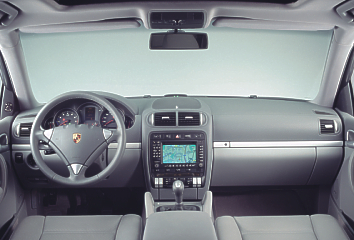
.
. .
..
. . . .
© 1999-2004
Copyright |
Porsche : The new six-cylinder Cayenne Six-cylinder power unit with Cayenne technology
Like its sister models, the new Porsche Cayenne ranks right at the top in the SUV segment in terms of engine output and performance: Maximum output of the six-cylinder power unit is 184 kW (250 bhp) at 6000 rpm, maximum torque is 310 Nm (228 lb-ft) between 2500 and 5500 rpm. With this kind of power and muscle, the Porsche Cayenne accelerates from 0 – 100 km/h in 9.1 seconds and has a top speed of 214 km/h or 133 mph. New six-speed gearbox with Porsche Drive-Off Assistant : PDOA The power of the six-cylinder engine is transmitted to the wheels in standard trim by a newly developed six-speed manual gearbox combined with an innovative assistance system: The Porsche Drive-Off Assistant or PDOA for short makes things much easier for the driver when setting out on an uphill gradient, securing the vehicle in position by automatically intervening in the brakes. Once the driver engages the clutch the system takes back brake pressure and the Cayenne sets off smoothly and safely en route to its destination. Porsche's six-speed Tiptronic S transmission is available as an alternative to the manual gearbox. Most advanced generation of four-wheel drive All models in the Cayenne range come with numerous highlights in technology to provide an ideal blend of supreme onroad and offroad driving characteristics. These include permanent four-wheel Porsche Traction Management (PTM) featured as standard conveying 62 per cent of the engine's power to the rear and 38 per cent to the front wheels in its basic mode. Depending on driving requirements, up to 100 per cent of engine power may be fed to the front or to the rear for optimum stability and performance. This distribution of power and torque is not based on traction (or the lack of traction) alone, but rather uses sensors to measure the speed of the vehicle, its lateral acceleration, the steering angle and operation of the gas pedal in order to calculate the optimum degree of wheel lock. When driving in rough terrain, the driver is furthermore able, through PTM, to activate a reduction gear in the power divider as well as a 100 per cent front-to-rear differential lock. Also fitted as standard, PSM Porsche Stability Management consistently interacts with PTM but only inter-venes when the Cayenne is being driven close to its physical limit.
Wide range of equipment Porsche remains true to its style also inside the Cayenne: The ignition lock is naturally to the left of the three-spoke steering wheel, and large circular instruments with a multifunction display in the middle present the most important vehicle data. Standard features in the Cayenne also include an alarm system, central locking with remote control, air conditioning, an onboard computer, electric window lifts and electrically adjustable front seats. The seats – and this also applies to the rear – are incidentally finished in leather. Superior transport concept The Cayenne not only offers five occupants ample space and lots of comfort, but is also ideal for travelling long distances thanks to its luggage capacity and transport options. The luggage compartment with its flat floor is fitted as standard with a luggage net as well as a rolling cover extending over the luggage area. Capacity is 540 litres. The ski bag featured as standard conveniently accommodates skis or other long objects within the car, with no need to fold down the rear seat bench.
Photos: Porsche/Automotive Intelligence From outside the Cayenne differs from the Cayenne S through its model name on the rear lid, brake callipers finished in eloxy black, and 17-inch light-alloy wheels in 10-spoke design. Summary The Cayenne offers supreme onroad qualities with a very high standard of dynamic performance for a Sports Utility as well a the Cayenne's equally exceptional offroad driving pleasures. And no question if you are driving the Cayenne in summer on dust-ridden or muddy offroad tracks or under typical winter conditions through snow and ice. (Dec. 02, 2003)
|
.
.
|














